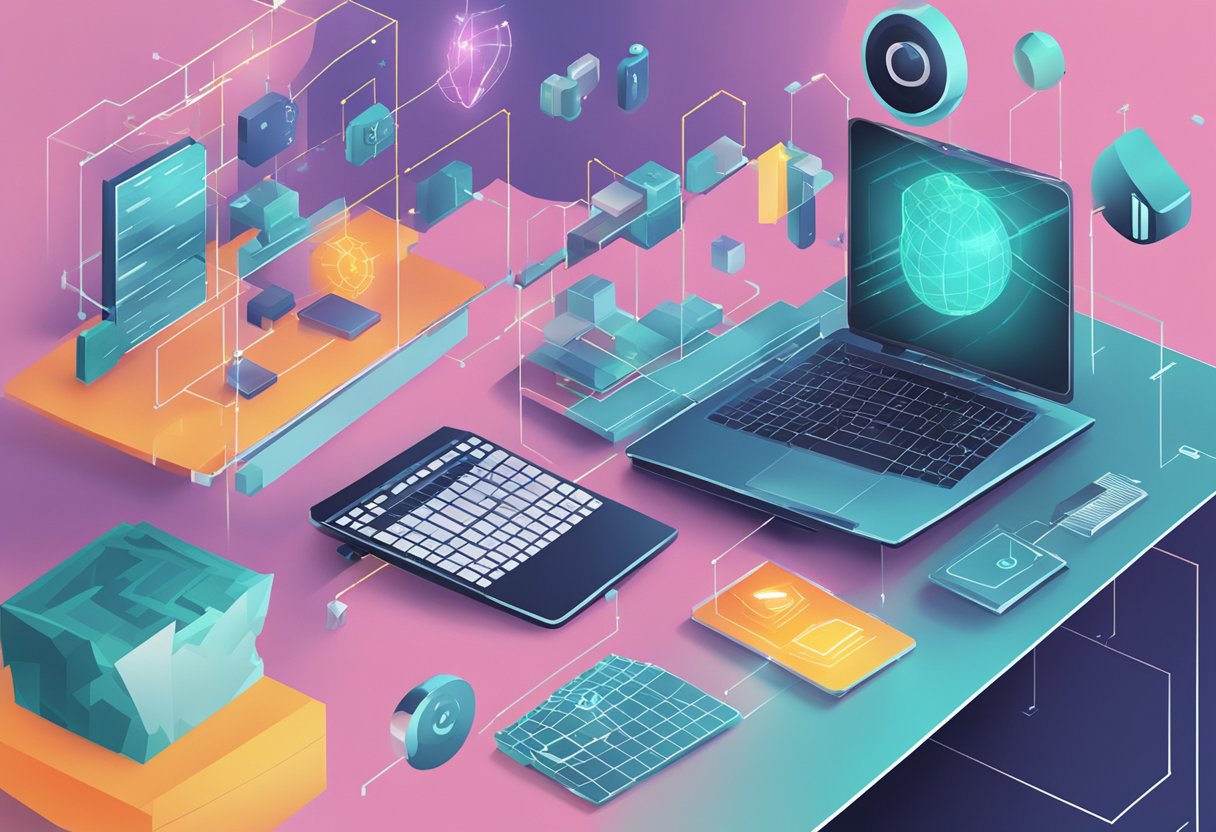How Technology Enables Better Legal Risk Management

Technology has been revolutionizing the legal industry, from streamlining administrative tasks to improving communication with clients. One area where technology is making a significant impact is in legal risk management. With the increasing complexity of regulations and the rise of cyber threats, effective risk management is crucial for businesses to avoid costly legal consequences.
Understanding Legal Risk Management is the first step towards implementing effective strategies. Legal risk management involves identifying, assessing, and mitigating potential legal risks that a business may face. This includes analyzing contracts, compliance with regulations, and potential lawsuits. By proactively managing legal risks, businesses can avoid costly legal battles and maintain their reputation in the market.
The Role of Technology in Legal Risk Management cannot be overstated. Technology can help businesses streamline legal risk management processes by providing quick and accurate data collection and analysis. It can also help in identifying potential risks and predicting future legal challenges. The use of Artificial Intelligence, Blockchain, and Cloud Computing can further enhance legal risk management. However, implementing technology in legal risk management comes with its own set of challenges. In the following sections, we will explore the impact of technology on legal risk management and the challenges businesses face in implementing these technologies.
Key Takeaways
- Legal risk management is crucial for businesses to avoid costly legal consequences.
- Technology plays a significant role in legal risk management, from quick and accurate data collection to predicting future legal challenges.
- The use of Artificial Intelligence, Blockchain, and Cloud Computing can enhance legal risk management, but implementing these technologies comes with challenges.
Understanding Legal Risk Management
Legal risk management is the process of identifying, assessing, and managing potential legal risks that an organization may face. It involves taking steps to minimize the likelihood of legal issues arising and to mitigate the impact of any legal issues that do arise.
Legal risks can arise from a variety of sources, including contracts, regulations, intellectual property, and litigation. Failure to effectively manage legal risks can result in costly legal disputes, reputational damage, and financial losses.
Effective legal risk management requires a thorough understanding of the legal landscape in which an organization operates, as well as the specific legal risks that may arise in the course of its business activities. This involves conducting regular risk assessments and implementing appropriate risk mitigation strategies.
Some common legal risk management strategies include:
- Contract management: Ensuring that contracts are properly drafted, reviewed, and enforced can help mitigate legal risks related to contractual obligations.
- Compliance monitoring: Regular monitoring of regulatory compliance can help identify potential legal risks and ensure that an organization is operating within the bounds of applicable laws and regulations.
- Intellectual property protection: Taking steps to protect intellectual property rights, such as trademarks and patents, can help mitigate legal risks related to infringement and misappropriation.
- Litigation management: Developing a plan for managing potential legal disputes, including alternative dispute resolution strategies, can help mitigate the impact of legal risks if they do arise.
By effectively managing legal risks, organizations can minimize the likelihood of legal issues arising and reduce the potential impact of any legal issues that do arise. Technology can play a critical role in enabling better legal risk management, as it can help automate many of the processes involved in identifying and mitigating legal risks.
Role of Technology in Legal Risk Management
Legal risk management is a crucial aspect of any organization, and technology has played a significant role in enhancing its efficiency. Technology can automate legal processes, analyze data, and generate reports that help identify and mitigate potential risks. This section will discuss the role of technology in legal risk management, focusing on automation of legal processes and data analysis and reporting.
Automation of Legal Processes
One of the primary benefits of technology in legal risk management is the automation of legal processes. Automation can help reduce the time and effort required to perform routine legal tasks, such as contract management, compliance monitoring, and litigation management. By automating these processes, organizations can ensure that they are consistently following legal requirements and mitigating potential risks.
For example, contract management software can automate the process of reviewing and approving contracts, reducing the risk of errors and missed deadlines. Compliance monitoring software can track regulatory changes and alert legal teams to potential compliance issues. Litigation management software can help legal teams manage cases more efficiently by automating tasks such as document management and deadline tracking.
Data Analysis and Reporting
Another critical role of technology in legal risk management is data analysis and reporting. Technology can help organizations collect, analyze, and report on legal data, providing insights into potential risks and opportunities for improvement. By analyzing legal data, organizations can identify patterns and trends that may indicate potential risks.
For example, data analysis can help organizations identify areas of non-compliance or potential legal disputes. Data reporting can provide legal teams with the information they need to make informed decisions about risk management strategies. By leveraging technology to collect and analyze legal data, organizations can proactively manage legal risks and ensure compliance with legal requirements.
In conclusion, technology can play a significant role in legal risk management by automating legal processes and providing data analysis and reporting capabilities. By leveraging technology to manage legal risks, organizations can ensure compliance with legal requirements, reduce the risk of legal disputes, and improve overall efficiency.
Impact of Artificial Intelligence
Artificial Intelligence (AI) has the potential to revolutionize legal risk management. It can help legal departments identify, assess, and mitigate risks more efficiently and effectively. Here are two ways in which AI can have a significant impact on legal risk management.
Predictive Analysis
One of the most promising applications of AI in legal risk management is predictive analysis. By analyzing large amounts of data, AI algorithms can identify patterns and predict future outcomes with a high degree of accuracy. In the legal context, this can be used to predict the likelihood of a particular legal outcome or to identify potential risks before they materialize.
For example, AI can be used to analyze past cases and identify the factors that led to a favorable or unfavorable outcome. This information can then be used to predict the likelihood of success in a new case with similar circumstances. Similarly, AI can be used to analyze contracts and identify potential risks, such as clauses that may be unenforceable or that may lead to disputes.
Contract Analysis
Another area where AI can have a significant impact on legal risk management is contract analysis. Contracts are a critical component of legal risk management, and AI can help legal departments analyze contracts more efficiently and accurately.
For example, AI can be used to identify clauses that may be problematic, such as clauses that are vague or ambiguous. AI can also be used to identify clauses that may be missing, such as clauses that are necessary to protect the company’s interests. By automating contract analysis, legal departments can save time and reduce the risk of errors.
In conclusion, AI has the potential to transform legal risk management by enabling predictive analysis and automating contract analysis. While there are still challenges to be addressed, such as ensuring the accuracy and fairness of AI algorithms, the potential benefits are significant.
Cybersecurity in Legal Risk Management
Legal risk management involves identifying and managing potential legal risks that an organization may face. With the increasing use of technology, cybersecurity has become a crucial aspect of legal risk management. Here are some sub-sections that highlight the importance of cybersecurity in legal risk management:
Data Protection
Data protection is a critical component of cybersecurity in legal risk management. Organizations collect and store sensitive data, including personal and financial information of their clients. Cybercriminals can use this data for identity theft, financial fraud, and other malicious activities. Therefore, it is essential to have robust data protection measures in place to safeguard against cyber-attacks.
One way to protect data is by using encryption. Encryption involves converting data into a code that only authorized users can access. This helps protect data from unauthorized access and ensures that sensitive information remains confidential.
Another way to protect data is by implementing access controls. Access controls restrict access to sensitive data to only authorized personnel. This helps prevent unauthorized access and ensures that data is only accessible to those who need it.
Fraud Detection
Fraud detection is another critical component of cybersecurity in legal risk management. Cybercriminals can use various tactics to commit fraud, including phishing, social engineering, and malware attacks. Therefore, it is essential to have robust fraud detection measures in place to detect and prevent fraud.
One way to detect fraud is by using machine learning algorithms. Machine learning algorithms can analyze large amounts of data and identify patterns that may indicate fraudulent activity. This helps organizations detect fraud quickly and take appropriate action to prevent further damage.
Another way to detect fraud is by using fraud detection software. Fraud detection software can analyze data in real-time and alert organizations to potential fraudulent activity. This helps organizations detect fraud quickly and take appropriate action to prevent further damage.
In conclusion, cybersecurity is a crucial aspect of legal risk management. By implementing robust data protection and fraud detection measures, organizations can protect themselves against cyber-attacks and mitigate legal risks effectively.
Blockchain and Legal Risk Management
Blockchain technology has the potential to revolutionize the way legal risk management is conducted. By providing a secure, decentralized, and transparent platform, blockchain can help law firms manage legal risks more efficiently and effectively.
Smart Contracts
One of the most significant benefits of blockchain technology for legal risk management is the use of smart contracts. Smart contracts are self-executing contracts with the terms of the agreement between buyer and seller being directly written into lines of code. They allow for the automation of contract management, reducing the need for intermediaries and increasing efficiency.
Smart contracts can also help reduce legal risks by ensuring that all parties comply with the terms of the contract. The code is immutable, meaning that once the contract is executed, it cannot be altered. This provides a high level of security and transparency, reducing the risk of fraud and disputes.
Secure Transactions
Another benefit of blockchain technology for legal risk management is the security of transactions. Blockchain provides a secure and transparent platform for transactions to take place, reducing the risk of fraud and ensuring that all parties are aware of the transaction details.
Blockchain technology uses cryptography to secure transactions, making it virtually impossible for unauthorized parties to access or alter the data. This provides a high level of security, reducing the risk of data breaches and other cybersecurity threats.
In conclusion, blockchain technology has the potential to significantly improve legal risk management by providing a secure, decentralized, and transparent platform for contract management and transactions. By leveraging smart contracts and secure transactions, law firms can reduce legal risks and increase efficiency.
Cloud Computing and Legal Risk Management
Cloud computing has become increasingly popular in recent years, and for good reason. It offers a range of benefits, including enhanced security, accessibility, and collaboration. In the legal industry, cloud computing can also play a critical role in enabling better legal risk management.
Remote Access
One of the key advantages of cloud computing is the ability to access data and applications remotely. This can be particularly beneficial for legal professionals who need to work from multiple locations or who need to collaborate with colleagues or clients in different parts of the world. With cloud computing, legal professionals can access critical data and applications from anywhere with an internet connection, making it easier to stay productive and efficient.
Cost Efficiency
Cloud computing can also be a cost-effective solution for legal risk management. By leveraging cloud-based services, legal professionals can avoid the upfront costs associated with purchasing and maintaining hardware and software. Additionally, cloud-based services often offer flexible pricing models, allowing legal professionals to pay only for what they use. This can be particularly beneficial for smaller law firms or legal departments with limited budgets.
Overall, cloud computing can be a valuable tool for legal risk management. By providing remote access and cost efficiency, cloud-based services can help legal professionals work more efficiently and effectively, while also mitigating legal risks.
Regulatory Technology (RegTech)
Regulatory Technology (RegTech) is a subset of Financial Technology (FinTech) that focuses on using technology to streamline and automate compliance and risk management processes. RegTech solutions are designed to help organizations stay informed of regulatory changes, prevent fraud, and assist with regulatory reporting.
Compliance Monitoring
RegTech solutions can help organizations monitor compliance with regulations by automating the process of collecting and analyzing data. This can include monitoring transactions, customer behavior, and employee activity. By automating compliance monitoring, organizations can reduce the risk of non-compliance and identify potential issues before they become a problem.
Risk Identification
RegTech solutions can also help organizations identify and manage risks more effectively. By using data analytics and machine learning, RegTech solutions can help organizations identify potential risks and provide insights into how to mitigate them. This can include identifying potential fraud or identifying areas where compliance risks are highest.
Overall, RegTech solutions can help organizations manage regulatory compliance and risk more effectively. By automating compliance monitoring and risk identification, organizations can reduce the risk of non-compliance and identify potential issues before they become a problem.
Challenges in Implementing Technology in Legal Risk Management
Data Privacy Issues
One of the main challenges in implementing technology in legal risk management is ensuring data privacy. With the increasing use of technology, there is a greater risk of data breaches and cyber attacks. Legal firms need to ensure that they have appropriate security measures in place to protect their clients’ data. This includes using secure communication channels, implementing access controls, and regularly monitoring and updating their security systems.
Another issue is complying with data privacy regulations such as GDPR and CCPA. Legal firms need to be aware of these regulations and ensure that their technology solutions comply with them. Failure to comply with these regulations can result in significant fines and legal action.
Technology Adoption Challenges
Another challenge in implementing technology in legal risk management is the adoption of new technology. Many legal professionals are resistant to change and may be hesitant to adopt new technology solutions. This can be due to a lack of understanding of the benefits of the technology or concerns about the cost and time required to implement it.
Moreover, adopting new technology requires a significant investment of time and resources. Small firms and solo practitioners may find it challenging to invest in technology adoption while also managing casework. However, many legal practitioners have found that the initial investment in technology can save time and resources in the long run.
In conclusion, legal firms face several challenges in implementing technology in risk management, including data privacy issues and technology adoption challenges. However, with appropriate measures in place, legal firms can leverage technology to manage legal risks more effectively.
Future Trends in Legal Risk Management Technology
Machine Learning
Machine learning is a type of artificial intelligence that allows computers to learn from data and improve their performance over time. In the context of legal risk management, machine learning can be used to analyze large amounts of data and identify patterns that may indicate potential legal risks. This technology can help legal teams to be more proactive in managing legal risks and to make more informed decisions.
One example of how machine learning can be used in legal risk management is in the analysis of contracts. By analyzing large numbers of contracts, machine learning algorithms can identify clauses and provisions that are associated with higher levels of risk. This can help legal teams to prioritize their review of contracts and to focus on the areas that are most likely to pose a risk.
Internet of Things (IoT)
The Internet of Things (IoT) refers to the network of connected devices that can communicate with each other and with the internet. In the context of legal risk management, IoT devices can be used to collect data that can be used to identify potential legal risks.
For example, IoT devices can be used to monitor workplace safety and to collect data on accidents and injuries. This data can be analyzed to identify patterns and trends that may indicate potential legal risks. Similarly, IoT devices can be used to monitor compliance with regulations such as environmental regulations or data privacy regulations.
Overall, the use of machine learning and IoT devices in legal risk management is still in its early stages, but it has the potential to significantly improve the efficiency and effectiveness of legal risk management. As these technologies continue to evolve, it is likely that they will become increasingly important tools for legal teams.
Conclusion
In conclusion, technology has the potential to greatly enhance legal risk management. By improving information storage and retrieval, automating routine work, and creating better workflow management, in-house counsel can focus on more strategic and high-value tasks. Natural language processing (NLP) algorithms can also be used to scan and analyze vast volumes of documents in seconds, extracting relevant information and identifying potential compliance issues or risks.
The use of technology can also help achieve better legal outcomes, as demonstrated by experts at the Gadens Government Lawyers Legal Update 2021. However, it is important to note that the traditional organization of firms may no longer be viable due to technology. As the online footprint of firms rapidly expands, web-based resources are exacerbating the culture of disintermediation as clients are able to cut out solicitors and seek legal advice directly from technology platforms.
Overall, the adoption of technology in legal risk management is a promising trend that can increase efficiency, reduce costs, and improve outcomes. However, it is important for organizations to carefully evaluate and select technologies that align with their specific needs and goals, and to ensure that they have the necessary expertise and resources to implement and maintain these technologies effectively.
Frequently Asked Questions
What are some benefits of using technology for risk management in the legal field?
Technology can provide several benefits for legal risk management, including quick and accurate data collection, improved collaboration among legal teams, and enhanced risk assessment and mitigation processes. By leveraging technology tools, legal professionals can streamline their workflows, reduce errors, and make more informed decisions.
How can technology improve the accuracy of legal risk assessments?
Technology can help legal professionals accurately assess risks by providing access to relevant data and analytics. By using predictive modeling and other advanced analytics techniques, legal teams can identify potential risks early on and take proactive measures to mitigate them. Additionally, technology tools can automate many of the manual tasks associated with risk assessment, reducing the risk of errors and improving the overall accuracy of assessments.
What are some examples of technology tools that can be used for legal risk management?
There are several technology tools available for legal risk management, including contract management software, e-discovery tools, compliance management software, and data analytics platforms. These tools can help legal teams automate manual tasks, improve collaboration, and gain insights into potential risks and opportunities.
How can businesses use technology to proactively identify and mitigate legal risks?
Businesses can use technology to proactively identify and mitigate legal risks by implementing risk management frameworks and leveraging data analytics tools. By collecting and analyzing data from various sources, including internal and external sources, businesses can identify potential risks and take proactive measures to mitigate them. Additionally, by using technology tools to automate compliance processes, businesses can reduce the risk of non-compliance and avoid costly legal disputes.
What role does data analytics play in technology-enabled legal risk management?
Data analytics plays a crucial role in technology-enabled legal risk management by providing legal teams with insights into potential risks and opportunities. By analyzing data from various sources, including internal and external sources, legal teams can identify patterns and trends that may indicate potential risks. Additionally, data analytics can help legal teams develop more accurate risk assessments and prioritize their risk mitigation efforts.
How can technology help streamline legal compliance processes?
Technology can help streamline legal compliance processes by automating many of the manual tasks associated with compliance management. By using compliance management software, legal teams can track regulatory changes, manage compliance workflows, and generate reports. Additionally, by using data analytics tools, legal teams can identify potential compliance issues early on and take proactive measures to address them.




